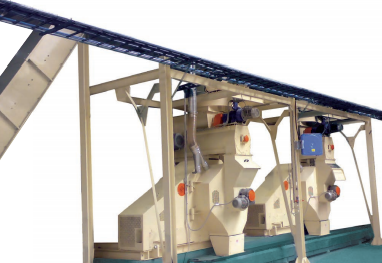Pelleting process of the fertilizer
The pelleting process of the fertilizers is particularly heavy for the Pellet Mill and, for this motivation, La Meccanica has designed a heavy-duty machine. The material should arrive with a maximum moisture content up to 20% but, as aforesaid, in the case of the drying of the pellets after the pelletizing, the compost can arrive at the Pellet Mill with a moisture content of 30%.
The most common pellet ø for fertilizers is from 3.5 up to 6 mm.
The dies are similar to the ones for the animal feed but with a wider countersink and a conical relieve (as the dies for wood pellets), so, it has a lower open area, compared with the animal feed dies.

All the pellet mills for fertilizers, are produced with Stainless Steel AISI 304, with forced feeding on the door, heavy-duty steel fabrications and the possibility to install an inverter. With the inverter there is an energy saving of about 10-12%, a reduction of the dies wearing and a better quality of the pellet, since the rotating speed of the die can be changed, according to the formula.
All the machines are supplied with the conditioner and screw feeder; in this case, the conditioner, is not used to add steam but to feed the pellet mill constantly. Many companies don't install the conditioner, but just a hopper over the door entrance. In this case, the Pellet Mill won’t work smoothly and continuously because the material arrives in the pelleting chamber in blocks, causing frequent clogging, swinging amperage and short life of the die. This happens because the material is light like sawdust and have to be pushed into the pelleting chamber, reason why we install the forced feeding.
Benefits of using the fertilizer in pellet instead of powder or granulate.
The benefits are several, but the ones below are the most important:
- Compared with the powder, the pellet is more easy to distribute evenly on the fields because the powder is uncontrollable in wind, rain and other atmospheric factors and, moreover, the pellet is more environmentally safe since it doesn’t spread with the wind.
- The absorption of the nutritional values of the pellet is more gradual and controllable than the powder fertilizer, and the agronomist can develop special formulas for each kind of farming.
- Other benefits are easier transport, storage and longer storage time.
About the granulated fertilizers for farming (not for horticulture or home small fertilizing), usually they have quite big diameters (around ø 8 mm) while the pellet can have diameters of ø 3.5 mm thus ensuring a more homogeneous distribution on the ground. The granulated fertilizers are mostly used for high contents of minerals (>50%) … usually the maximum content of minerals in the fertilizers pellets is 40%.